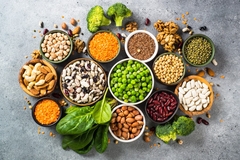
- Industry news
Industry news
- Category news
Category news
- Reports
- Key trends
- Multimedia
- Journal
- Events
- Suppliers
- Home
- Industry news
Industry news
- Category news
Category news
- Reports
- Key trends
- Multimedia
- Events
- Suppliers
Frozen food boom: Cost of living crisis prompts a shift toward the freezer category

24 Apr 2023 --- Frozen food offers a haven for mindful consumers looking for more value for money in their grocery baskets as the cost of living crisis surges on and supermarket prices for basic food items skyrocket forcing people to think differently about their food choices.
That’s the situation in the UK (and elsewhere) which is facing the highest inflation since the 1970s.
Households in Britain and beyond are already squeezed.
And now, shoppers are increasingly turning to frozen food to reduce waste and get a longer shelf life from their groceries as many frozen brands up their game in terms of quality, offering what they describe as “restaurant quality” frozen meals and products.

What’s happening in the frozen food category is in line with Innova Market Insights’ Top Ten Trend for 2023, “Redefining Value” which details how cost and value for money have become more important to more than half of F&B consumers worldwide. Today’s shoppers are increasingly exploring money-saving strategies, such as choosing lower-cost items and cooking from scratch.
UK consumer’s association Which? found in a 2022 survey that one in five households bought more frozen food. Moreover, it unveiled that “buying frozen food could save you money for the majority of the items in our analysis.” The organization found lower prices in foods such as breaded cod, raspberries, pork sausages, meat feast pizzas, chips and broccoli.
 Rupert Ashby, CEO of the British Frozen Food Federation.Some frozen foods, such as mixed frozen vegetables, have not been able to escape inflation, accelerating in price by 31.9%, between September 2021 and September 2022, and being one of the lowest-cost everyday grocery items that have increased more in price, according to the UK Office for National Statistics.
Rupert Ashby, CEO of the British Frozen Food Federation.Some frozen foods, such as mixed frozen vegetables, have not been able to escape inflation, accelerating in price by 31.9%, between September 2021 and September 2022, and being one of the lowest-cost everyday grocery items that have increased more in price, according to the UK Office for National Statistics.
Nonetheless, most frozen products have remained competitive.
“One of the main reasons why frozen food is often significantly cheaper than the fresh or chilled alternative is due to the amount of waste generated in the fresh food supply chain when goods are damaged or spoil before they are sold,” Rupert Ashby, chief executive of the British Frozen Food Federation, tells FoodIngredientsFirst.
“Our members have worked hard to ensure that frozen food remains an affordable option for consumers who do not want to compromise on enjoying tasty, healthy and nutritious meals at home,” Ashby notes.
“Additionally, supply and demand are much more stable with frozen food, which is available all year round due to its long shelf life. Therefore, unlike with fresh produce, consumers aren’t charged a premium for out-of-season food that’s been grown in artificial conditions or flown in from overseas,” he continues.
Can’t waste expensive food
With food staples becoming luxury items, which have been security tagged in stores – and in the past some supermarkets have hired meat monitors to prevent theft – consumers can’t afford to be wasteful.
“The most common reasons for food waste are that fresh or chilled food is purchased then left unused and that households often cook or prepare too much, which alone results in 1.6 million metric tons of food waste a year,” Ashby explains.
UK anti-food waste NGO WRAP recently released a study finding that oversized portions in out of home eating contributed heavily to food waste.
“Frozen food provides a solution to this problem as it reduces waste in two ways. Firstly, it has a much longer shelf life, which means less food going off before consumers get the chance to eat it and less wastage throughout the supply chain. Secondly, frozen produce can be easily portioned so consumers can cook only what they need and save the rest for another day,” he continues. Nomad Foods disclosed 12.8% higher revenue growth in 2022 and expects solid organic growth for this year.
Nomad Foods disclosed 12.8% higher revenue growth in 2022 and expects solid organic growth for this year.
In the same vein, a Nomad Foods spokesperson, tells FoodIngredientsFirst that “during times of economic downturn, frozen food remains a highly convenient, sustainable and affordable option for consumers, with minimal food waste.”
The company disclosed 12.8% higher revenue growth in 2022 and “organic sales across the business are continuing to grow.”
Sustainability “at heart”
In a Life Cycle Assessment study, Nomad Foods looked into the carbon emissions of its frozen products in comparison with its non-frozen alternatives.
“Results for the 22 frozen products assessed under the new study showed that 18 had an equal or lower carbon footprint than similar products using other preservation methods,” says the spokesperson.
“A big reason for this is down to the data on food loss and waste at both a retailer and consumer level, which revealed significant benefits to frozen food in terms of longer-food preservation and reduced food waste, further demonstrating frozen foods’ sustainability credentials,” the spokesperson continues.
Of the analyzed frozen products, three had 30% lower carbon footprints than their non-frozen alternatives, which used other preservation methods. Eight had 10% lower emissions,13 had similar emissions, and three had higher emissions that ranged between 10% and 15%.
“Sustainability is at the heart of the frozen food industry and the industry is making huge strides in sustainable farming, production and logistics,” Ashby adds.
 Which? found in a 2022 survey that one in five households bought more frozen food.“Though it should form a key part of the industry’s sustainability strategy, the significant impact of food waste on this country’s carbon emissions is often overlooked. UK households waste an incredible 4.5 million metric tons of edible food every year and this food waste is known to be responsible for up to 10% of global greenhouse gas emissions,” he notes.
Which? found in a 2022 survey that one in five households bought more frozen food.“Though it should form a key part of the industry’s sustainability strategy, the significant impact of food waste on this country’s carbon emissions is often overlooked. UK households waste an incredible 4.5 million metric tons of edible food every year and this food waste is known to be responsible for up to 10% of global greenhouse gas emissions,” he notes.
Nutritious meals?
According to Ashby, nutrients are locked in when food is frozen, making it a premium and health option. Furthermore, it doesn’t require preservatives.
“Studies have found that frozen produce will typically contain a higher level of nutrients than fresh, which will have been stored for several days before reaching the supermarket shelf. For example, fresh spinach loses 75% of its vitamin C content two days after picking. This loss is reduced to just 20% when spinach is frozen,” Ashby explains.
Meanwhile, Nomad Foods has worked in the last few years to reduce the number of sales coming from high-fat, sugar and salt foods (HFFS). In 2014, 85% of Birds Eye’s net sales were non-HFSS. By 2022, it was 93%. Upon acquiring Aunt Bessie’s in 2018, 81% of net sales were non-HFSS. By 2022, it was 92%.
The company explains that by the end of 2023, 100% of Goodfellas pizza recipes will be non-HFSS.
Ashby adds that reformulation and innovation in the category have allowed brands to sell “restaurant-grade food for us all to cook at home.”
“The quality and value of frozen food make me believe we are at the start of a ‘frozen food boom’ as households across the country will purchase and enjoy more frozen food than ever before,” he concludes.
By Marc Cervera











